Brood X Emerges!
Air Date: Week of May 21, 2021
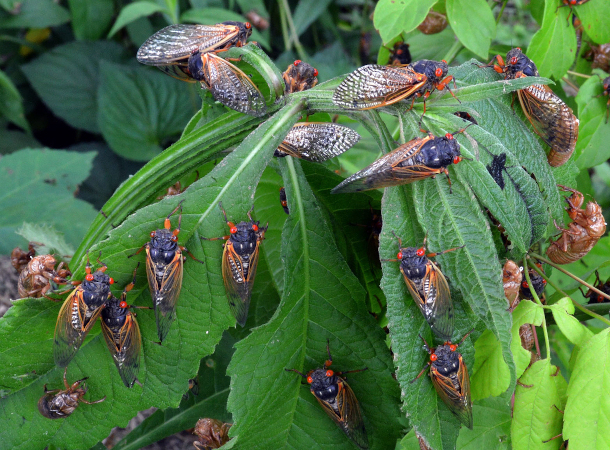
Brood X is emerging in May 2021 after 17 years underground. (Photo: Gene Kritsky, Mount St. Joseph University)
Brood X is here at last: trillions of cicadas, underground for the last 17 years, are burrowing up through the soil and emerging in numerous Eastern and Midwestern states to transform, sing, and mate. Professor Gene Kritsky of Mount St. Joseph University joins Host Bobby Bascomb to explain the music of cicadas and the ecological benefits they bring.
Transcript
BASCOMB: It’s Living on Earth, I’m Bobby Bascomb.
[CICADA SYMPHONY SFX]
BASCOMB: Brood 10 is here at last! Trillions of cicadas, underground for the last 17 years, are burrowing up through the soil and emerging in numerous Eastern and Midwestern states. They’ll shed their nymphal skins, sing their deafening songs and mate. Then, they’ll die and it’s all over until 2038 when the next generation emerges from the ground. To learn more we called up cicada expert, Gene Kritsky. He’s the dean of Behavioral and Natural Sciences and a Professor of Biology at Mount St. Joseph University in Cincinnati, Ohio. Gene, welcome to Living on Earth!
KRITSKY: Glad to be here.
BASCOMB: So, you're joining us from Ohio, which is ground zero for this explosion in cicadas. What exactly does it look and feel like to be part of that?
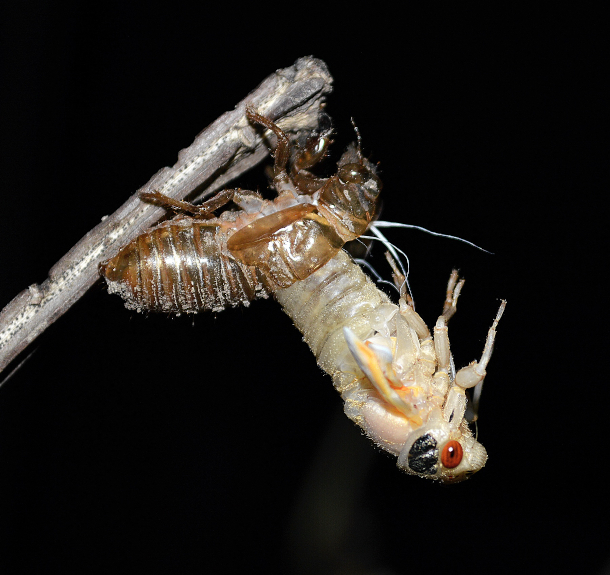
A cicada emerges from its nymphal skin. The adult cicada is initially ghostly white with tiny compacted wings, but soon turns black as its exoskeleton hardens. (Photo: Gene Kritsky, Mount St. Joseph University)
KRITSKY: Well, it starts with they start emerging in mass numbers. And you're waiting for that, you're taking soil temperatures, or you're looking at models. And that evening, when they start coming out, that's when the soil temperature is 64 degrees Fahrenheit; usually a day where you have a nice soaking rain, that really softens things up in the soil, and they come out. And you go out after dark. And you're hearing this crunching as they're falling from the trees onto dry leaves, for example. And you look at the trees, you watch these things climb up the tree, locking their legs into that vertical surface of the tree trunk, or a brick wall or fence, or what have you. And then the back of the cicada nymph splits. And you see this white space appear, and eventually it gets a little wider, and then the head capsule splits on the top. And then the whole adult pulls itself out of the old nymphal skin, wriggles is abdomen free. And there you have it, it's a separate adult now. It's got shriveled up little wings, it's creamy white with red eyes and two black patches behind the head. And then for the next half hour, 40 minutes, it starts expanding the wings by pumping fluid through it, and the wings get bigger and bigger and bigger. And then finally they look like, they're all held in place, tent-like over the back of the abdomen, just like a cicada should, except they're creamy white, with red eyes and black patches. And then it takes another hour and a half for them to actually turn dark and get the orange color to their wing veins, membranous veins, and turn into the typical adult cicada.
BASCOMB: Wow, so interesting. You know, but at the same time, it kind of seems like something out of a horror movie! I mean, all of these creatures just coming out of the ground at the same time. It's intriguing, but also kind of creepy in a way.
KRITSKY: Yeah, I can, I can see why you'd say that! I actually observed this in a cemetery one night. And all of a sudden, you're, here with all the, all the headstones or whatever. All of a sudden, you see that the ground is moving with these things. And they're actually climbing up the headstones and transforming into the adults off of the headstones. Yeah! [LAUGHS]
BASCOMB: So the cicadas are just about to hatch out now. What next? Tell us, please, about the full life cycle of cicadas once they emerge.
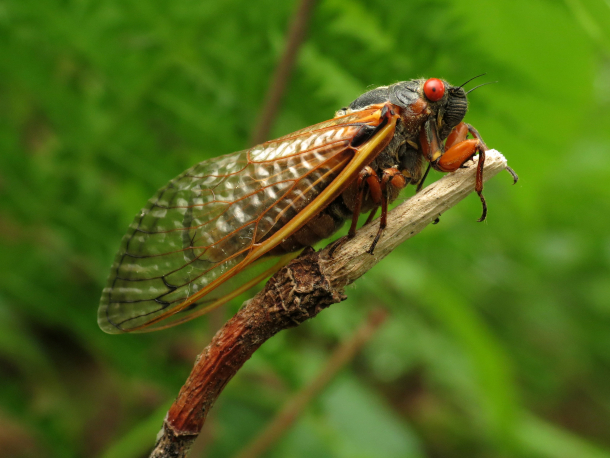
An adult periodical cicada. (Photo: Katja Schulz, Flickr, CC BY 2.0)
KRITSKY: Sure, after they've transformed into the adult, they're going to climb to the top of the trees for about five days. It's really strange because for the few days after they first started coming out, you don't hear any calling. That doesn't start till about five days later after they've completed the hardening of their exoskeleton, and they're ready to fly and sing. Males gather in large numbers in trees, we call it a chorusing center, where all these males gather and start singing. Females fly into the, into the tree. A male sings; she responds by flicking her wings. If he hears that, he'll walk closer and call again. She'll flick her wings, he'll walk closer; and then eventually mating ensues. Mating can last several hours. And then after that is completed, the female will start laying her eggs within the next couple of days. She'll lay 500 eggs in the terminal growth of tree branches. And then she and the male die. Those eggs will be in the trees just under the bark. And six to ten weeks later, they'll start hatching. And the nymph wiggles its way free from the egg nest, and then just drops to the ground and they're gone. And it's almost instantaneous. And they'll feed on grassroots or other herbaceous roots for a few weeks. And then on New Year's Day, they'll be eight to ten, twelve inches below the surface, sucking on a tree root. And that's where they'll be for the next 17 years. While they're under there, they're not hibernating, they're not sleeping, they're not dormant. They're sucking on tree roots, they're growing. They molt four times during that period, they will probably, don't move no more than about a meter from where they first went into the ground. But they will tunnel around looking for tree roots and what have you. And then by year 13, they're in there, they've already molted now to their last immature stage. And so, for 17-year cicadas, they won't molt again, until they emerge and form the adult that'll occur in May of the year. And so that's the life cycle. Doesn't sound very exciting, but it's obviously been successful.

A map showing Brood X locations. (Image: Gene Kritsky, Mount St. Joseph University)
BASCOMB: So aside from the sheer number of them that come out, the other really distinguishing feature is the sound that they make. How do they make that sound, and do different species make the same sound? Or can you actually tell the difference from hearing them?
KRITSKY: Well, there are three different species of 17-year cicadas, and they can be differentiated by the color pattern of their abdomen, on the underside of the abdomen, but also by their calls. The chorusing and the individual calls are made with a structure called the tymbal. And this is a membranous structure that's ribbed, found just under the wings of the first abdominal segment. Inside the cicada male's body, there are muscles that are attached to that. And when they contract, they cause those ribs to buckle, which makes a sound. A good analogy: take a bendy straw, and pull it out and push it back in, and hear that little "zzzz". But do that now 250 times a second! The male abdomen is mostly hollow, it's mostly just an airspace to help resonate that as well. So that's the making of the sound. Females don't have a tymbal, so she is silent except for flicking of her wings, that's how she responds. Get them all together into one large group, and --
[CICADA SOUNDS]
KRITSKY: it's almost like a surreal experience. The largest species of cicada, Magicicada septendecim, it's the one that has the call, that's sometimes is referred to as sounding like the word -- "Pharoah"...
[MAGICICADA SEPTENDECIM CALLS]
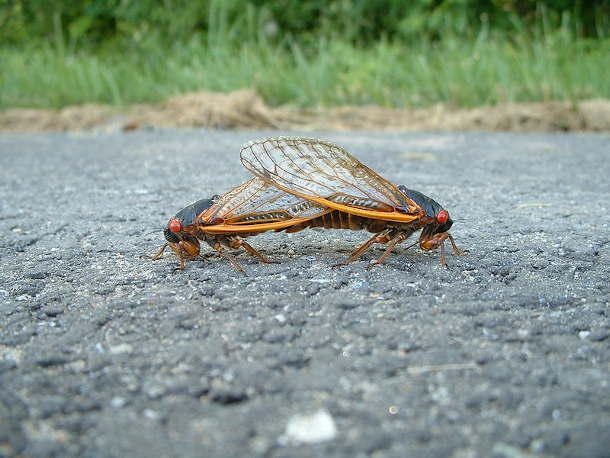
Brood X cicadas mating in 2004: the generation that spawned the 2021 cicadas. (Photo: superbatfish, Flickr, CC BY 2.0)
KRITSKY: To me, it's what a Foley artist would have used for the flying saucers in a 1950s science fiction movie. Now, Magicicada Cassinii, this has a series of buzz and clicks.
[MAGICICADA CASSINII CALLS]
KRITSKY: But when they're together in a large chorus, it sounds like, like -- "shhhhhh". So you have this high-pitched, sort of hollow sound with the flying saucers call, and then "shhh" below that. And you can hear those two tones very readily in chorusing centers. The third species, decula, is the rarest of all: five, maybe ten percent in some locations. And to me it sounds like a rotary sprinkler head, it's buzz and clicks, but it's --
[MAGICICADA SEPTENDECULA CALLS]
KRITSKY: And so if you're lucky to get all three, you could have, just blend them together. And that's what your full-fledged chorus would be. And then to get, to add a little more spice to it, make it about 96 decibels, which is on par with a rock concert.
[CICADA CHORUS]
KRITSKY: That's the music of a cicada symphony.
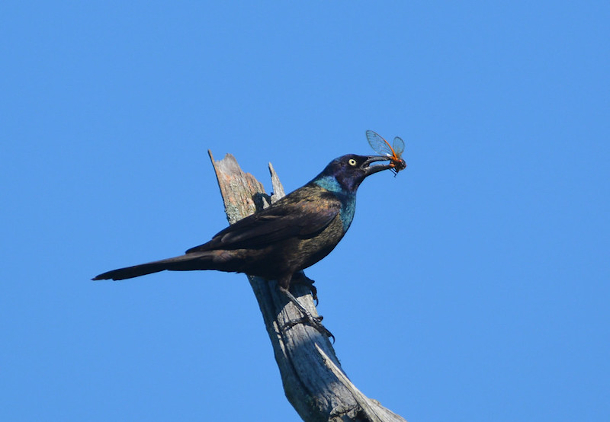
A grackle with a cicada snack. Periodical cicadas are so numerous when they emerge that they provide a huge feast for birds, squirrels, raccoons, snakes, moles and more. (Photo: Jen Goellnitz, Flickr, CC BY-NC 2.0)
BASCOMB: So there are literally trillions of these insects that are emerging right now in the Eastern part of the United States. What kind of ecological role do cicadas play when they come out? I mean, it's a sudden influx of a species that hasn't been there for 17 years. How does that affect the ecosystem?
KRITSKY: Well, that's the neat thing about periodical cicadas. They are uniquely adapted to life in the Eastern deciduous forest. And if we were able to sort of wipe out all the periodical cicadas, I think the forest would still be here. But when they do emerge, and during the life cycle, they do some considerable good for the ecosystem. Unlike beavers, for example, they may not alter the ecosystem, but they're good for its survival. For example, when the cicadas are underground during those 17 years, they are turning over soil, and they're tunneling. When they emerge, they come out of these holes about the side and diameter of your little pinky, your little finger.

Gene Kritsky is the author of Periodical Cicadas: The Brood X Edition. (Image: Courtesy of Gene Kritsky)
And these holes persist, they don't all disappear right away. And that's like a natural aeration for the soil, and in the warm summer months, if you have a very heavy rain, in most cases, you have these heavy drenching downpours, and a lot of that water runs off into the creeks and the Ohio River eventually. But a lot of that water gets down those holes, it helps water those trees. So that's, that's beneficial as well. When the periodical cicadas come out and transform into adults, and even at the nymphal stage, they'll be providing food for animals. It's an opportunistic food pulse that's just amazing. Raccoons, squirrels, birds, of all kind, thoroughly enjoy periodical cicadas. And some people might not think that having more rodents would be a good thing. But in natural areas, more rodents mean more food for owls and raptors. And so it can help those populations increase for this year, which may help more offspring to go into the future. Then, all these cicadas die. And these carcasses collect at the base of trees. You get a nice morning dew from a cool summer night, the next morning, or a nice summer rain, get them wet; add some 90 degree temperatures, and these things rot. And they really stink to high heaven! And as they decay, the nutrients from those rotting cicadas go into the soil around the trees, helping the trees but also helping the cicadas that are feeding on those trees.
BASCOMB: What do you think people should do if they want to learn more about cicadas? How can people get involved?
KRITSKY: Well, the first thing to do is to download the app Cicada Safari. It was an app that I developed with the Center for IT Engagement at the university. What this app does is it asks you to help us map out where Brood X is. You go out, you get the app, and then got out on your own cicada safari. And go looking for where the maps tell us that it is, but also it's important to go looking for it where it once was or where, might be adjacent counties. Already we've had cicadas emerge this year from areas where we did not expect them. Go out there, find a cicada, you photograph it from your, your app and submit it. The value of Cicada Safari is it is a citizen science project where there's verification. We're tickled with this, we're expecting now 90,000 to 100,000 photographs this year.

Professor Kritsky takes a look at some adult periodical cicadas. (Photo: Courtesy of Gene Kritsky)
BASCOMB: Gene Krinsky is Dean of the Behavioral and Natural Sciences and a Professor of Biology at Mount St. Joseph University. Thank you so much for joining me today, Gene.
KRITSKY: It was a pleasure, thank you.
Links
Learn more and become a citizen scientist with the Cicada Safari app
Listen to Gene Kritsky’s Living on Earth interview about beekeeping in ancient Egypt
Find Gene Kritsky’s book, Periodical Cicadas: The Brood X Edition
Living on Earth wants to hear from you!
Living on Earth
62 Calef Highway, Suite 212
Lee, NH 03861
Telephone: 617-287-4121
E-mail: comments@loe.org
Newsletter [Click here]
Donate to Living on Earth!
Living on Earth is an independent media program and relies entirely on contributions from listeners and institutions supporting public service. Please donate now to preserve an independent environmental voice.
NewsletterLiving on Earth offers a weekly delivery of the show's rundown to your mailbox. Sign up for our newsletter today!
 Sailors For The Sea: Be the change you want to sea.
Sailors For The Sea: Be the change you want to sea.
 The Grantham Foundation for the Protection of the Environment: Committed to protecting and improving the health of the global environment.
The Grantham Foundation for the Protection of the Environment: Committed to protecting and improving the health of the global environment.
 Contribute to Living on Earth and receive, as our gift to you, an archival print of one of Mark Seth Lender's extraordinary wildlife photographs. Follow the link to see Mark's current collection of photographs.
Contribute to Living on Earth and receive, as our gift to you, an archival print of one of Mark Seth Lender's extraordinary wildlife photographs. Follow the link to see Mark's current collection of photographs.
 Buy a signed copy of Mark Seth Lender's book Smeagull the Seagull & support Living on Earth
Buy a signed copy of Mark Seth Lender's book Smeagull the Seagull & support Living on Earth

